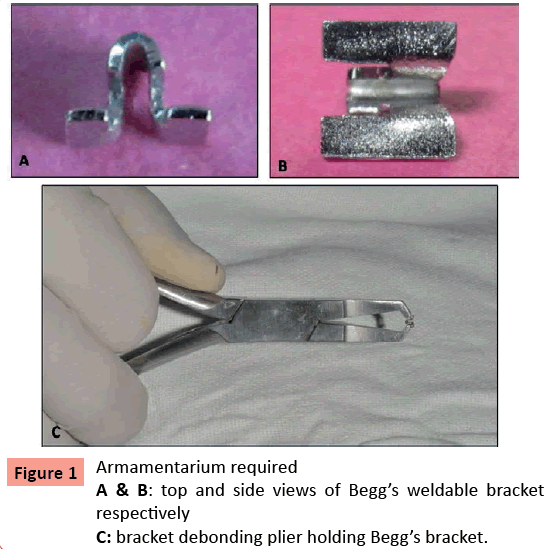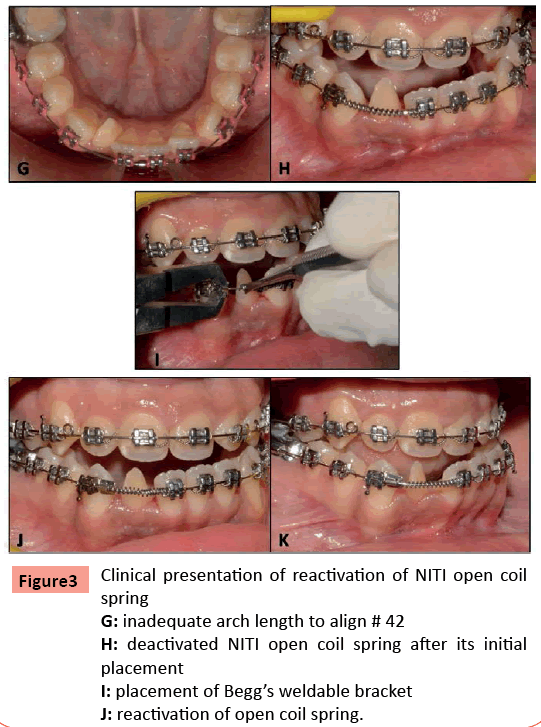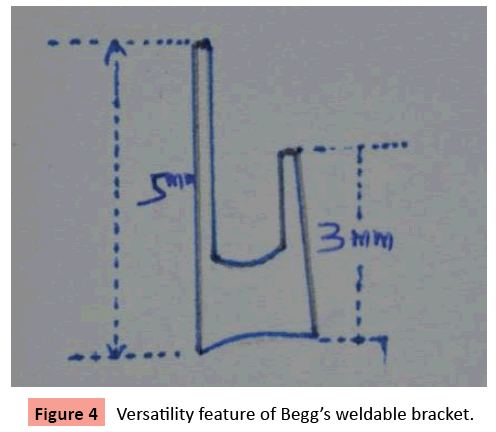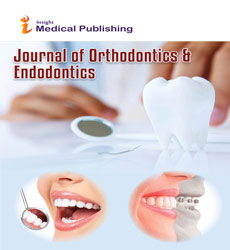ISSN : ISSN 2469-2980
Journal of Orthodontics & Endodontics
Use Of Begg's Bracket To Reactivate NITI Open Coil Spring- A Quick Chairside Method
Unit of Orthodontics, Oral Health Sciences Centre, Post Graduate Institution of Medical Education and Research, Chandigarh-160012, India
Abstract
Nickel titanium open coil springs are often used to create space for alignment of malposed teeth. However, sometime orthodontist is confronted with situation where less interbracket span exists between teeth and periodic reactivation of NITI open coil spring is required. This article highlights the chairside intraoral method of reactivation of open coil spring via the use of weldable Begg’s bracket without removing the base archwire.
Introduction
Use of Nickel Titanium open coil spring to regain sufficient arch length is well established method in day to day orthodontic practice. However, certain clinical situation do exist e.g. rotated and lingually placed teeth, where, it is difficult to place sufficient length of open coil spring [1] for space creation and therefore, often requires periodic removal of archwire until sufficient amount of space is created to align malposed teeth. Other methods to reactivate NITI open coil spring as given in literature are; split stainless steel tubings [2,3] , addition of 1.5 to 2mm extra length of open coil spring[4], spreading the coils apart by squeezing the adjacent helix with pliers [4], C- rings fabricated from stainless steel rectangular archwires[5] and composite stop [6,7]. Here we present very simple yet effective and quick chairside method to reactivate open coil spring using Begg’s weldable bracket* (Figure 1A and B) without archwire removal.
Technique
Hold the weldable type Begg’s bracket with bracket debonding or Howe’s plier as shown in Figure 1C.
Expose the base archwire by pushing the open coil spring to one side with ligature tucker (Figure 2D).
Place the Begg’s bracket over the base archwire in edgewise fashion and crimp to secure it on the wire (Figure 2E).
Release the coil spring so that it contacts the end of Begg’s bracket and is reactivated (Figure 2F).
This method of reactivating open coil spring is demonstrated in a case with severe rotation of lower right central incisor as shown in Figure 3(G-K). After initial placement of open coil spring, the decompressed spring was re-compressed with Begg’s bracket without archwire removal.
With the use of Begg’s bracket* to reactivate NITI open coil spring, approximately 3 to 5mm of space can be regained per single bracket, as this bracket design has versatility feature (e.g. if gingival end of bracket faces towards open coil spring, it will reactivate it by 3mm, and 5mm vice versa).
Discussion
Previously proposed method for reactivation of open coil spring demand to have some sort of clinical expertise viz. split tubings [2], cutting C-shaped tube into required length [3], addition of extra length of spring[4], fabrication of C-rings[5] and making vertical stop and composite bead [6,7]. Our technique to reactivate NITI open coil spring does not require any clinical expertise. Begg’s bracket can be easily placed on both rectangular as well as round stainless steel archwires. It can be inserted very easily on 0.016”× 0.022” and 0.017”×0.025” or 0.019”×0.025” stainless steel working archwires for 0.018” and 0.022” slot respectively.
Versatality in design of these brackets provide the operator an activation range of 3 - 5mm. Our clinical experience with these brackets have shown that after single reactivation, no further reactivation was required and this technique have been used in more than 300 cases. Other method like flowable composite bead [6] slips especially over round stainless steel wire and requires manual dexterity. Stop loop with composite bead method [7] requires removal of archwire leading to increased chair side time. These brackets are most economic to use than addition of extra length of NITI open coil or conventional method of reactivation of open coil spring. Although we need to stock these Begg’s weldable brackets, yet the advantages they provide in terms of saving extra chairside time, easy to use, require minimal clinical expertise and cost effectiveness should make choice of an orthodontist to keep them in their armamentarium.
References
- Manhartsberger C, Seidenbusch W (1996) Force delivery of Ni-Ti coil springs. Am J Orthod Dentofacial orthop 109: 8-21.
- Gottlieb, E.L (1968) Slit-tubing. J Clin Orthod 2:523.
- Samuels RHA, Rudge SJ (2000) A quick and simple method of reactivating space-opening push-coil springs. J Clin Orthod 34:706-708.
- Binder RE (2000) Two rapid methods of reactivating open-coil springs. J Clin Orthod 34:103-104.
- Yadav SK, Yadav DS (2012) C- rings for reactivation of open-coil spring. J Clin Orthod 46:503.
- Sahu SK, Barik AK, Nayak TK (2012) Reactivation of open coil springs: A novel, intraoral procedure. J Ind Orthod Soc 46:167-168.
- Ahmed SVK, Krishnaswamy NR, George AM, Faizee SH, Anand MK (2014) Reactivation of open-coil springs using composite stops. J Clin Orthod 48:317-318.
Open Access Journals
- Aquaculture & Veterinary Science
- Chemistry & Chemical Sciences
- Clinical Sciences
- Engineering
- General Science
- Genetics & Molecular Biology
- Health Care & Nursing
- Immunology & Microbiology
- Materials Science
- Mathematics & Physics
- Medical Sciences
- Neurology & Psychiatry
- Oncology & Cancer Science
- Pharmaceutical Sciences




